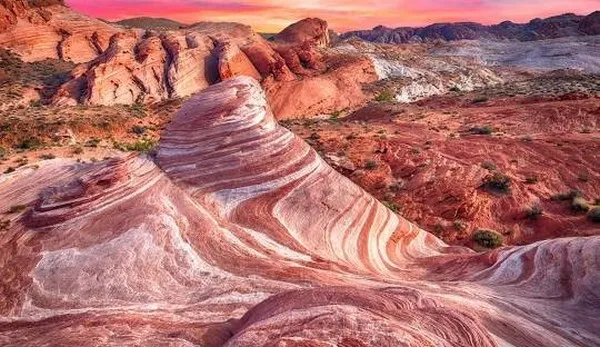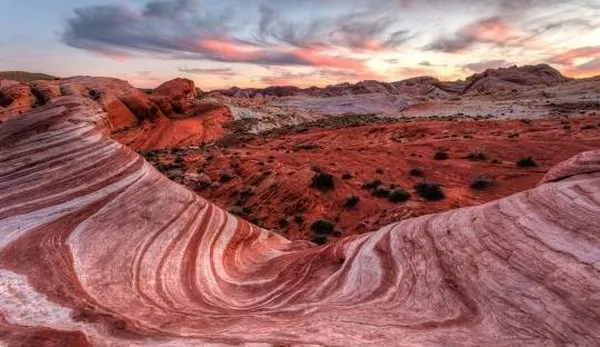If you’re planning to explore the raw beauty of Nevada, don’t miss Valley of Fire State Park. This place is not only famous for its vibrant red sandstone formations but also a harsh environment that requires visitors to be well-equipped with survival knowledge and skills. From packing essentials to coping with extreme weather, let’s discover valuable survival tips to ensure a safe and memorable trip to Valley of Fire.

Valley of Fire: More Than Just a Tourist Destination
Established in 1935, Valley of Fire State Park is Nevada’s oldest state park. Spanning over 46,000 acres, it offers a unique landscape of fiery red sandstone formations sculpted over millions of years. The name “Valley of Fire” comes from the rock’s distinctive color, especially when illuminated by the setting sun, creating a magnificent spectacle. Furthermore, Valley of Fire preserves traces of the ancient Paiute people, with ancient petroglyphs etched into the rocks, evidence of a civilization that once thrived here.
Packing Essentials: The Key to Safety
The first and most crucial survival tip when visiting Valley of Fire is to pack your gear meticulously. The harsh desert environment demands thorough preparation to cope with unexpected weather conditions.
Water: Top Priority
In a desert environment, dehydration is the biggest threat. You need to bring enough drinking water for the entire day, even more than you anticipate. Estimate about 4-6 liters of water per person as necessary, especially if you plan to hike or trek. Use insulated water bottles to keep your water cool for longer.
Appropriate Clothing: Protecting Your Body
Choose light-colored, loose-fitting, and breathable clothing to minimize heat absorption. Long-sleeved shirts and pants help protect your skin from direct sunlight and insects. A wide-brimmed hat and sunglasses are essential accessories to shield your face and eyes.
Sunscreen: Skin’s Protective Shield
The sun’s rays in the desert are intense, so apply high SPF sunscreen (SPF 30 or higher) to your entire body, including often-missed areas. Reapply sunscreen every 2-3 hours or after sweating.
Hiking Boots: Reliable Companions
Choose hiking boots with good traction, comfort, and a proper fit to prevent blisters. It’s advisable to use shoes that are already broken in to avoid discomfort throughout your journey.
Snacks: Fueling Your Body
Carry energy-rich snacks like protein bars, nuts, dried fruits, or bread to replenish energy when needed. Avoid foods that spoil easily in high temperatures.
Map and Compass/GPS: Accurate Navigation
Valley of Fire has numerous trails, but not all are clearly marked. Bring a detailed park map and a compass or GPS device for navigation, especially if you plan to explore remote areas.
First-Aid Kit: Handling Emergencies
Prepare a basic first-aid kit with items like bandages, antiseptic wipes, pain relievers, allergy medication, and insect repellent. If you have any medical conditions, bring your prescription medications and inform your companions.

Essential Survival Skills: Facing Every Challenge
In addition to packing essentials, you also need to equip yourself with necessary survival skills to handle unexpected situations that may arise in the desert environment.
Finding Water Sources: A Matter of Life and Death
In case you run out of water, you need to know how to find natural water sources. Although Valley of Fire doesn’t have many water sources, you might find water in rock crevices or canyons after rainfall. Use a clean cloth to filter the water before drinking to remove sediment.
Building a Makeshift Shelter: Shielding from the Sun
If you get lost or have to stay overnight, find a natural shelter like a cave or the shade of a large tree. If none is available, you can build a makeshift shelter using branches and leaves to shield yourself from the sun and stay warm at night.
Starting a Fire: Staying Warm and Signaling
Knowing how to start a fire is a crucial skill for staying warm, cooking food, and signaling for rescue. Carry a lighter, waterproof matches, or a fire starter. Look for flammable materials like dry grass, bark, or dry leaves for tinder.
Navigating by the Sun and Stars: Finding Your Way Out
If you get lost and don’t have a map or GPS, you can use the sun and stars for navigation. The sun rises in the east and sets in the west. At night, you can locate the North Star to determine north.
Signaling for Rescue: Increasing Your Chances of Being Saved
If you encounter trouble, try to signal for rescue. Use a mirror or metal object to reflect sunlight. Create smoke by building a fire and adding fresh leaves or damp branches.

Important Notes: Ensuring Absolute Safety
Besides the survival tips above, you should also note the following to ensure absolute safety throughout your trip:
- Check the weather forecast before going: Avoid going on extremely hot or stormy days.
- Inform family or friends about your plans: Let them know where you are going, when you will return, and who to contact in case of emergency.
- Travel in a group: It’s safer to travel in a group than alone.
- Stay on marked trails: Avoid straying into dangerous areas.
- Do not climb on unstable rocks: The risk of falling and injury is high.
- Stay away from wildlife: Do not feed or approach them.
- Do not litter: Keep the environment clean.
- Comply with park regulations: Read signs and instructions carefully.

Conclusion
Valley of Fire is a fantastic destination for those who love exploring raw nature. However, to have a safe and memorable trip, you need to equip yourself with essential survival knowledge. By preparing your gear thoroughly, learning survival skills, and adhering to safety precautions, you will be able to fully enjoy the beauty of Valley of Fire without encountering any danger. Remember that thorough preparation is the key to a successful and safe trip in the harsh desert environment of Nevada. Have a fascinating journey exploring Valley of Fire!